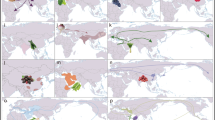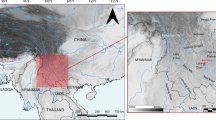Fifty Years Later—The Legacy of Alfred Crosby’s “The Columbian Exchange: Biological and Cultural Consequences of 1492”

Fifty Years Later—The Legacy of Alfred Crosby’s “The Columbian Exchange: Biological and Cultural Consequences of 1492.” It has been 50 years since the publication of Alfred Crosby’s revolutionary book on what he coined the “Columbian Exchange.” Crosby’s observations have stood the test of time and remain rock solid. There has been little argument about his central premise that the arrival of the Iberians in the New World was a collision that dramatically changed the whole world. All the work following his classic text has been of addition and expansion, not correction. Much greater detail has been provided on the “Great Dying” associated with the arrival of European diseases and the homogenization of New and Old World crops and livestock in the Americas. Information has also been generated on related topics little explored by Crosby including the following: 1) intra-hemispheric crop movements before the voyages of Columbus, 2) the crop homogenization that occurred during the European colonization of North America, 3) the role of the Portuguese and their African slave trade on the dissemination of crops across the world, 4) the inter-hemispheric exchange of wild plant species associated with migration, and 5) the cultural aspects associated with the Columbian Exchange. Herein is a review of the literature that has been published on the Columbian Exchange since Crosby’s ground-breaking masterpiece first appeared.
This is a preview of subscription content, log in via an institution to check access.
Access this article
Subscribe and save
Springer+ Basic
€32.70 /Month
- Get 10 units per month
- Download Article/Chapter or eBook
- 1 Unit = 1 Article or 1 Chapter
- Cancel anytime
Buy Now
Price includes VAT (France)
Instant access to the full article PDF.
Rent this article via DeepDyve
Similar content being viewed by others

Exchanges of economic plants along the land silk road
Article Open access 29 December 2022

Climate Change and Migration Among Early Agriculturalists: From Global to Mississippian Perspectives
Chapter © 2022

The origins of multi-cropping agriculture in Southwestern China: Archaeobotanical insights from third to first millennium B.C. Yunnan
Article Open access 25 May 2022
Literature Cited
- Alencar, N. L., T. A. de Sousa Araújo, E. L. C. de Amorim, and U. P. de Albuquerque. 2010. The inclusion and selection of medicinal plants in traditional pharmacopoeias—evidence in support of the diversification hypothesis. Economic Botany 64(1): 68-79. ArticleGoogle Scholar
- Alpern, S. B. 1992. The European introduction of crops into West Africa in precolonial times. History in Africa 19: 13-43. ArticleGoogle Scholar
- Anderson, E. 1952. Plants, man and life. Boston: Little Brown and Company. BookGoogle Scholar
- Austin, D. F. 2013. Moonflower (Ipomoea alba, Convolvulaceae)—medicine, rubber enabler, and ornamental: a review. Economic Botany 67(3): 244-262. ArticleCASGoogle Scholar
- Barickmann, B. J. 1974. A bit of land, which they call Roça: Slave provision grounds in the Bahian Recôncavo, 1780-1860. The Hispanic American Historical Review 74: 649-687. Google Scholar
- Berry, M.A. 1985. The age of maize in the greater Southwest: a critical review. In: Prehistoric Food Production in North America, ed. I. Ford, 279-308. Ann Arbor: Museum of Anthropology, University of Michigan.
- Bidwell, P. W., and J. I. Falconer 1925. History of agriculture in the northern United States, 1620-1860 (No. 358). Washington: Carnegie Institution of Washington.
- Boomgaard, P. 2003. In the shadow of rice: Roots and tubers in Indonesian history, 1500-1950. Agricultural History 77: 582-610. ArticleGoogle Scholar
- Bush, M. B., D. R. Piperno, and P. A. Colinvaux. 1989. A 6,000 year history of Amazonian maize cultivation. Nature 340: 303–305. ArticleGoogle Scholar
- Butzer, K. W. and E. K. Butzer. 1995. Transfer of the Mediterranean livestock economy to New Spain: Adaptations and consequences. In: Global land use change, eds. B. L. Turner II and A. Gomez Sal, 151-193. Madrid: Consejo Superior de Investigaciones Cientificas.
- Butzer, K. W. 1995. Biological transfer, agricultural change, and environmental implications of 1492. In: International Germplasm Transfer: Past and Present, ed. R. R. Duncan, 1-29. CSSA Special Publications Crop Society of America Volume 23.
- Carney, J. A. 2001. Black rice. Boston: Harvard University Press. BookGoogle Scholar
- Carney, J. A., and R. N. Rosomoff. 2009. In the shadow of slavery: Africa’s botanical legacy in the New World. Berkeley: University of California Press. BookGoogle Scholar
- Chapman, J. 2000. The impact of the potato. History Magazine. https://www.history-magazine.com/potato.html. Accessed 10 Sep 2022.
- Chen, S. and J. K. Kung. 2016. Of maize and men: the effect of a New World crop on population and economic growth in China. Journal of Economic Growth 21: 71–99. ArticleGoogle Scholar
- Chomkos, S.A. and G. N. Crawford. 1978. Plant husbandry in prehistoric eastern North America: new evidence for its development. American Antiquity 43: 405-408.
- Cook, N. D. 1998. Born to die: disease and New World conquest, 1492-1650 (Vol. 1). Cambridge, New York: Cambridge University Press. Google Scholar
- Crawford, R. D. 1992. Introduction to Europe and diffusion of domesticated turkeys from the America. Archivos de Zootecnia 41: 307-314. Google Scholar
- Crosby, A. W. 1972. The Columbian Exchange; Biological and cultural consequences of 1492. Westport, Connecticut: Greenwood Press. Google Scholar
- Crosby, A.W. 1986. Ecological Imperialism: The Biological expansion of Europe, 900 – 1900. Cambridge, New York: Cambridge University Press. Google Scholar
- Cusack, I. 2020. Ripples from the Columbian Exchange? Dublin Gastronomy Symposium. https://arrow.tudublin.ie/cgi/viewcontent.cgi?article=1190&context=dgs
- De Jong, H. 2016. Impact of the potato on society. American Journal of Potato Research 93(5): 415-429. ArticleGoogle Scholar
- DeWitt, D. 2014. Precious cargo: How foods from the Americas changed the world. Berkeley: Counterpoint. Google Scholar
- Dobyns, H. F. 1983. Their number become thinned. Knoxville: University of Tennessee Press. Google Scholar
- Duffin, J. 2002. Poisoning the spindle: Serendipity and discovery of the anti-tumor properties of the Vinca alkaloids (Part I). Pharmacy in History 44(2):64-76. PubMedGoogle Scholar
- Earle, R. 2012. The body of the conquistador: Food, race and the colonial experience in Spanish America, 1492–1700. Cambridge, New York: Cambridge University Press. BookGoogle Scholar
- Emory, K.P. and Y.H. Sinoto. 1964. Préhistoire de la polynésie. Journal of the Société des Océanistes 20: 39-41.
- Faust, F. X., C. Gnecco, H. Mannstein, and J. Stamm. 2006. Evidence for the postconquest demographic collapse of the Americas in historical CO2 levels. Earth Interactions 10: 1-14. https://doi.org/10.1175/EI157.1.
- Fuller, D. Q., N. Boivin, T. Hoogervorst, and R. Allaby. 2011. Across the Indian Ocean: the prehistoric movement of plants and animals. Antiquity 85(328): 544-558. ArticleGoogle Scholar
- Gade, D. W. 1986 The Iberian pig in the Central Andes. Journal of Cultural Geography 7: 35-5. ArticleGoogle Scholar
- Gade, D. W. 1992. Landscape, system, and identity in the post-Conquest Andes. Annals of the American Association of Geographers 82: 461-477. Google Scholar
- Gade, D. W. 2015. Particularizing the Columbian Exchange: Old World biota to Peru. Journal of Historical Geography 48: 26-35. ArticleGoogle Scholar
- Gade, D. W. 1975. Plants, man and the land in the Vilcanota Valley of Peru. Biogeographica 6. The Hague: W. Junk B. V. Publishers.
- Hancock, J. F. 2012. Plant evolution and the origin of crop species. Wallingford, UK: CABI.
- Hancock, J. F. 2021. Spices, scents and silk: Catalysts of trade. Wallingford, UK: CABI International. BookGoogle Scholar
- Hancock, J. F. 2022. History of world agriculture before and after 1492: Legacy of the Columbian Exchange. Switzerland: Springer Nature.
- Janick, J. 2013. Development of new world crops by Indigenous Americans. HortScience 48(4): 406-412. ArticleGoogle Scholar
- Katz, E. 2009. Chili Pepper, from Mexico to Europe: Food, imaginary and cultural identity. In: Food, imaginaries and cultural frontiers. Essays in honour of Helen Macbeth, eds. F. X. Medina, R. Ávila, and I. de Garine, 213-232. Guadalajara: Universidad de Guadalajara, Colección Estudios del Hombre, Serie Antropología de la Alimentación.
- Kloppenburg, J. R. 1988. First the seed: The political economy of plant biotechnology 1492-2000. Cambridge, New York: Cambridge University Press. Google Scholar
- Koch, A., C. Brierley, M. M. Maslin, and S. L. Lewis. 2019. Earth system impacts of the European arrival and Great Dying in the Americas after 1492. Quaternary Science Reviews 207: 13-36. ArticleGoogle Scholar
- Macinnis, P. 2002. Bittersweet: The story of sugar. Sydney: Crow’s Nest, Allen & Unwin. Google Scholar
- Mann, C. 2011. How the potato changed the world. Smithsonian Magazine 11. https://www.smithsonianmag.com/history/how-the-potato-changed-the-world-. Accessed 10 Sep2022.
- McNeil, J. R. 1999. How the potato changed the world’s history. Food, Nature, and Culture 66: 67-83. Google Scholar
- McNeill, J. R. 1986. Agriculture, forests, and ecological hstory: Brazil, 1500-1984. Environmental Review 10: 122-133. ArticleGoogle Scholar
- Murphy, C., and D. Fuller. 2017. The agriculture of early India. Oxford Research Encyclopedia of Environmental Science. https://doi.org/10.1093/acrefore/9780199389414.013.169ArticleGoogle Scholar
- Neukom, R., J. Gergis, D. J. Karoly, H. Wanner, M. Curran, J. Elbert, F. González-rouco, B. K. Linsley, A. D. Moy, I. Mundo, C. C. Raible, E. J. Steig, T. V. Ommen, T. Vance, R. Villalba, J. Zinke, and D. Frank. 2014. Inter-hemispheric temperature variability over the past millennium. Nature Climate Change 5: 362-367. ArticleGoogle Scholar
- Norton, M. 2008. Sacred gifts, profane, pleasures. Ithaca, New York: Cornell University Press. Google Scholar
- Nunn, N., and N. Qian. 2010. The Columbian Exchange: A History of disease, food, and ideas. The Journal of Economic Perspectives 24: 163-188. ArticleGoogle Scholar
- Osseo-Asare, A. D. 2014. Bitter roots: The search for healing plants in Africa. Chicago, IL: University of Chicago Press. Google Scholar
- Parker, M. 2011. The sugar barons. family, corruption, empire, and the West Indies. New York: Walker Publishing Company, Inc. Google Scholar
- Paster, E. 2018. The secret Sephardic history of the pumpkin. The Norsher (October 25, 2018).
- Pfeiffer, J. M., and R. A. Voeks. 2008. Biological invasions and biocultural diversity: linking ecological and cultural systems. Environmental Conservation 35(4): 281-293. ArticleGoogle Scholar
- Pickersgill, B. 1969. The archeological record of chili peppers (Capsicum spp.). American Antiquity 35: 54-61.
- Piperno, D. R. 2011. The origins of plant cultivation and domestication in the New World tropics: Patterns, process, and new developments. Current Anthropology 52(S4): S453-S470. ArticleGoogle Scholar
- Russell-Wood, A. J. R. 1998. The Portuguese Empire 1415-1808: A world on the move. Baltimore and London: John Hopkins University Press. BookGoogle Scholar
- Sauer, C. O. 1952. Agricultural origins and dispersals. New York: The American Geographical Society. Google Scholar
- Sauer, J. D. 1993. Historical geography of crop plants: a select roster. Boca Raton: CRC press. Google Scholar
- Story, D.A. 1985. Adaptive strategies of archaic cultures of the West Gulf Coastal Plain. In: Prehistoric Food Production in North America, ed. R.I. Ford. Museum of Anthropology, Ann Arbor: University of Michigan.
- Van Andel, T. 2010. African Rice (Oryza glaberrima Steud.): Lost crop of the enslaved Africans discovered in Suriname. Economic Botany 64 (1): 1-10. ArticlePubMedPubMed CentralGoogle Scholar
- Vandebroek, I., and R. Voeks. 2018. The gradual loss of African Indigenous vegetables in tropical America: A review. Economic Botany 72(4): 543-571. ArticleGoogle Scholar
- Watkins, C. 2021. Palm Oil Diaspora: Afro-Brazilian landscapes and economies on Bahia’s dendê coast. Cambridge, New York: Cambridge University Press. BookGoogle Scholar
Acknowledgements
There are no competing interests, and no research support was received. The author is responsible for all the research and manuscript preparation. Data sets have not been deposited in public repositories. No direct contact was made with local people and communities. The manuscript was greatly improved by the suggestions of two anonymous reviewers, especially Editor-in-Chief Ina Vandebroek, who insisted on an expansion of the original manuscript and much more information on the cultural aspects of the Columbian Exchange.
Author information
Authors and Affiliations
- Department of Horticulture, Michigan State University, East Lansing, MI, USA James F. Hancock
- James F. Hancock



